Inhibition of TNF-α-Induced Collagen Degradation and Oxidative Damage by Centipeda minima and Brevilin A in Human Dermal Fibroblasts
Abstract
1. Introduction
2. Materials and Methods
2.1. Plant Materials and Preparation of CMX
2.2. Cell Culture and Sample Preparation
2.3. Cell Viability
2.4. Measurement of Intracellular ROS
2.5. Measurement of Nitric Oxide (NO) Production
2.6. Measurement of Protein Secretion
2.7. Western Blotting
2.8. Statistical Analysis
3. Results
3.1. Content of Brevilin A in CMX
Effects of CMX and Brevilin A on Intracellular ROS Accumulation and MMP-1 and COLIA1 Secretion in TNF-α-Stimulated NHDFs
3.2. Effects of CMX and Brevilin A on NO and PGE2 Overproduction in TNF-α-Stimulated NHDFs
3.3. Effects of Brevilin A on TNF-α-Stimulated Phosphorylation of Mitogen-Activated Protein Kinases (MAPKs) in NHDFs
4. Discussion
5. Conclusions
Author Contributions
Funding
Institutional Review Board Statement
Informed Consent Statement
Data Availability Statement
Conflicts of Interest
Abbreviations
| COLIA1 | Collagen Type I Alpha 1 |
| COX-2 | Cyclooxygenase 2 |
| DCFDA | 2′,7′-Dichlorodihydrofluorescein Diacetate |
| ERK | Extracellular Signal-Regulated Kinase |
| iNOS | Inducible Nitric Oxide Synthase |
| JNK | Jun N-terminal Kinase |
| MAPKs | Mitogen-Activated Protein Kinases |
| MMP-1 | Matrix Metallopeptidase 1 |
| NHDFs | Normal Human Dermal Fibroblasts |
| NO | Nitric Oxide |
| P38 | p38 Mitogen-Activated Protein Kinase |
| PGE2 | Prostaglandin-E2 |
| ROS | Reactive Oxygen Species |
| TNF-α | Tumor Necrosis Factor-Alpha |
| UV | Ultraviolet |
References
- Tobin, D.J. Introduction to skin aging. J. Tissue Viability 2017, 26, 37–46. [Google Scholar] [CrossRef] [PubMed]
- Babizhayev, M.A.; Yegorov, Y.E. Reactive oxygen species and the aging eye: Specific role of metabolically active mitochondria in maintaining lens function and in the initiation of the oxidation-induced maturity onset cataract—A novel platform of mitochondria-targeted antioxidants with broad therapeutic potential for redox regulation and detoxification of oxidants in eye diseases. Am. J. Ther. 2016, 23, e98–e117. [Google Scholar]
- Kim, Y.-J.; Lee, E.-H.; Cho, E.-B.; Kim, D.-H.; Kim, B.-O.; Kang, I.-k.; Jung, H.-Y.; Cho, Y.-J. Protective effects of galangin against UVB irradiation-induced photo-aging in CCD-986sk human skin fibroblasts. Appl. Biol. Chem. 2019, 62, 40. [Google Scholar] [CrossRef]
- Puri, P.; Nandar, S.K.; Kathuria, S.; Ramesh, V. Effects of air pollution on the skin: A review. Indian J. Dermatol. Venereol. Leprol. 2017, 83, 415. [Google Scholar] [PubMed]
- Oh, S.-r.; Park, S.-k.; Lee, P.; Kim, Y.-M. The ginsenoside Rg2 downregulates MMP-1 expression in keratinocyte (HaCaT)-conditioned medium-treated human fibroblasts (Hs68). Appl. Biol. Chem. 2023, 66, 85. [Google Scholar] [CrossRef]
- Lee, J.W.; Peng, L.; Jegal, H.; Park, N.-J.; Bong, S.-K.; Lee, J.W.; Pyo, J.J.; Choi, Y.; Kim, S.-N. The soybean cultivar SCEL-1 shows potent anti-photoaging effects in a UV-induced three-dimensional human skin and hairless mouse model. Appl. Biol. Chem. 2022, 65, 6. [Google Scholar] [CrossRef]
- Naidoo, K.; Hanna, R.; Birch-Machin, M.A. What is the role of mitochondrial dysfunction in skin photoaging? Exp. Dermatol. 2018, 27, 124–128. [Google Scholar] [CrossRef]
- Shin, J.-W.; Kwon, S.-H.; Choi, J.-Y.; Na, J.-I.; Huh, C.-H.; Choi, H.-R.; Park, K.-C. Molecular mechanisms of dermal aging and anti-aging approaches. Int. J. Mol. Sci. 2019, 20, 2126. [Google Scholar] [CrossRef]
- Lee, H.-Y.; Kim, J.-S. Cherry fruit anthocyanins cyanidin-3-O-glucoside and cyanidin-3-O-rutinoside protect against blue light-induced cytotoxicity in HaCaT cells. Appl. Biol. Chem. 2023, 66, 3. [Google Scholar] [CrossRef]
- Zhu, X.; Jiang, M.; Song, E.; Jiang, X.; Song, Y. Selenium deficiency sensitizes the skin for UVB-induced oxidative damage and inflammation which involved the activation of p38 MAPK signaling. Food Chem. Toxicol. 2015, 75, 139–145. [Google Scholar] [CrossRef]
- Choi, D.H.; Hwang, H.S. Anti-inflammation activity of brazilin in TNF-α induced human psoriasis dermatitis skin model. Appl. Biol. Chem. 2019, 62, 1–9. [Google Scholar] [CrossRef]
- Chen, J.; Jiao, D.; Zhang, M.; Zhong, S.; Zhang, T.; Ren, X.; Ren, G. Concentrated growth factors can inhibit photoaging damage induced by ultraviolet A (UVA) on the human dermal fibroblasts in vitro. Med. Sci. Monit. Int. Med. J. Exp. Clin. Res. 2019, 25, 3739. [Google Scholar] [CrossRef]
- Wang, L.; Oh, J.-Y.; Lee, W.; Jeon, Y.-J. Fucoidan isolated from Hizikia fusiforme suppresses ultraviolet B-induced photodamage by down-regulating the expressions of matrix metalloproteinases and pro-inflammatory cytokines via inhibiting NF-κB, AP-1, and MAPK signaling pathways. Int. J. Biol. Macromol. 2021, 166, 751–759. [Google Scholar] [CrossRef]
- Kim, D.Y.; Won, K.-J.; Hwang, D.I.; Lee, S.Y.; Choi, I.-H.; Kim, B.; Lee, H.M. Essential oil from Chrysanthemum boreale flowers modulates SNARE protein-linked mast cell response and skin barrier proteins and ameliorates atopic dermatitis-like lesions in mice. Hortic. Environ. Biotechnol. 2022, 63, 287–298. [Google Scholar] [CrossRef]
- Weihermann, A.; Lorencini, M.; Brohem, C.; De Carvalho, C. Elastin structure and its involvement in skin photoageing. Int. J. Cosmet. Sci. 2017, 39, 241–247. [Google Scholar] [CrossRef]
- Lee, S.; Jang, T.; Kim, K.H.; Kang, K.S. Improvement of Damage in Human Dermal Fibroblasts by 3, 5, 7-Trimethoxyflavone from Black Ginger (Kaempferia parviflora). Antioxidants 2022, 11, 425. [Google Scholar] [CrossRef] [PubMed]
- Min, D.-H.; Yu, Y.-B.; Kim, T.-H.; Kim, H.; Lee, S. Pharmacological effects of pentacyclic triterpenoids isolated from Centella asiatica. Hortic. Environ. Biotechnol. 2024, 65, 189–197. [Google Scholar] [CrossRef]
- Hwang, E.; Park, S.; Yang, J.-E. Anti-aging, anti-inflammatory, and wound-healing activities of edible bird’s nest in human skin keratinocytes and fibroblasts. Pharmacogn. Mag. 2020, 16, 336–342. [Google Scholar]
- Zhang, M.; Hwang, E.; Lin, P.; Gao, W.; Ngo, H.T.; Yi, T.-H. Prunella vulgaris L. exerts a protective effect against extrinsic aging through NF-κB, MAPKs, AP-1, and TGF-β/Smad signaling pathways in UVB-aged normal human dermal fibroblasts. Rejuvenation Res. 2018, 21, 313–322. [Google Scholar] [CrossRef]
- Kim, B.H.; Lee, W.-Y.; Trinh, T.A.; Pyo, J.S.; Lee, S.; Kim, C.-E.; Lee, D.H.; Park, E.-S.; Kang, K.S. Hair growth effect of emulsion extracted Brevilin a, a JAK3 inhibitor, from Centipeda minima. Processes 2020, 8, 767. [Google Scholar] [CrossRef]
- Kim, B.H.; Lee, M.J.; Lee, W.-Y.; Pyo, J.; Shin, M.-S.; Hwang, G.S.; Shin, D.; Kim, C.E.; Park, E.-S.; Kang, K.S. Hair growth stimulation effect of Centipeda minima extract: Identification of active compounds and anagen-activating signaling pathways. Biomolecules 2021, 11, 976. [Google Scholar] [CrossRef] [PubMed]
- Choi, Y.J.; Lee, S.Y.; Son, S.-R.; Park, J.Y.; Jang, D.S.; Lee, S. The Effects of Flavonol and Flavone Glucuronides from Potentilla chinensis Leaves on TNF-α-Exposed Normal Human Dermal Fibroblasts. Antioxidants 2023, 12, 1803. [Google Scholar] [CrossRef]
- Ahmed, I.A.; Mikail, M.A.; Zamakshshari, N.; Abdullah, A.-S.H. Natural anti-aging skincare: Role and potential. Biogerontology 2020, 21, 293–310. [Google Scholar] [CrossRef] [PubMed]
- Lee, S.; Hoang, G.D.; Kim, D.; Song, H.S.; Choi, S.; Lee, D.; Kang, K.S. Efficacy of alpinumisoflavone isolated from Maclura tricuspidata fruit in tumor necrosis factor-α-induced damage of human dermal fibroblasts. Antioxidants 2021, 10, 514. [Google Scholar] [CrossRef]
- Kim, K.S.; Son, S.-R.; Choi, Y.J.; Kim, Y.; Ahn, S.-Y.; Jang, D.S.; Lee, S. Rosarugosides A and D from Rosa rugosa Flower Buds: Their Potential Anti-Skin-Aging Effects in TNF-α-Induced Human Dermal Fibroblasts. Plants 2024, 13, 1266. [Google Scholar] [CrossRef] [PubMed]
- Jang, H.-Y.; Kim, G.-B.; Kim, J.-M.; Kang, S.Y.; Youn, H.-J.; Park, J.; Ro, S.Y.; Chung, E.-Y.; Park, K.-H.; Kim, J.-S. Fisetin Inhibits UVA-Induced Expression of MMP-1 and MMP-3 through the NOX/ROS/MAPK Pathway in Human Dermal Fibroblasts and Human Epidermal Keratinocytes. Int. J. Mol. Sci. 2023, 24, 17358. [Google Scholar] [CrossRef]
- Novotná, R.; Škařupová, D.; Hanyk, J.; Ulrichová, J.; Křen, V.; Bojarová, P.; Brodsky, K.; Vostálová, J.; Franková, J. Hesperidin, hesperetin, rutinose, and rhamnose act as skin anti-aging agents. Molecules 2023, 28, 1728. [Google Scholar] [CrossRef]
- Fernando, I.P.S.; Dias, M.K.H.M.; Madusanka, D.M.D.; Kim, H.-S.; Han, E.-J.; Kim, M.-J.; Seo, M.-J.; Ahn, G. Effects of (–)-loliolide against fine dust preconditioned keratinocyte media-induced dermal fibroblast inflammation. Antioxidants 2021, 10, 675. [Google Scholar] [CrossRef]
- Hseu, Y.-C.; Chang, C.-T.; Gowrisankar, Y.V.; Chen, X.-Z.; Lin, H.-C.; Yen, H.-R.; Yang, H.-L. Zerumbone exhibits anti-photoaging and dermatoprotective properties in ultraviolet A-irradiated human skin fibroblast cells via the activation of Nrf2/ARE defensive pathway. Oxidative Med. Cell. Longev. 2019, 2019, 4098674. [Google Scholar] [CrossRef]
- Oh, J.H.; Kim, J.; Karadeniz, F.; Kim, H.R.; Park, S.Y.; Seo, Y.; Kong, C.-S. Santamarine shows anti-photoaging properties via inhibition of MAPK/AP-1 and stimulation of TGF-β/smad signaling in UVA-irradiated HDFs. Molecules 2021, 26, 3585. [Google Scholar] [CrossRef]
- Hwang, E.; Ngo, H.T.; Park, B.; Seo, S.-A.; Yang, J.-E.; Yi, T.-H. Myrcene, an aromatic volatile compound, ameliorates human skin extrinsic aging via regulation of MMPs production. Am. J. Chin. Med. 2017, 45, 1113–1124. [Google Scholar] [CrossRef] [PubMed]
- Seetharaman, R.; Park, S.Y.; Yoon, M.K.; Kwak, J.H.; Son, B.G.; Park, Y.H.; Kang, J.S.; Lee, Y.J.; Choi, Y.H.; Bae, Y.S. Heme oxygenase-1-mediated anti-inflammatory effect of a novel garlic compound in RAW264. 7 murine macrophages. Hortic. Environ. Biotechnol. 2014, 55, 148–157. [Google Scholar] [CrossRef]
- Lee, S.; Han, S.; Kim, H.M.; Lee, J.M.; Kim, J.; Park, C.-G.; Lee, S. Simultaneous determination of luteolin and luteoloside in dandelions using HPLC. Hortic. Environ. Biotechnol. 2011, 52, 536–540. [Google Scholar] [CrossRef]
- Wang, L.; Lee, W.; Cui, Y.R.; Ahn, G.; Jeon, Y.-J. Protective effect of green tea catechin against urban fine dust particle-induced skin aging by regulation of NF-κB, AP-1, and MAPKs signaling pathways. Environ. Pollut. 2019, 252, 1318–1324. [Google Scholar] [CrossRef]
- Choi, H.-J.; Alam, M.B.; Baek, M.-E.; Kwon, Y.-G.; Lim, J.-Y.; Lee, S.-H. Protection against UVB-induced photoaging by Nypa fruticans via inhibition of MAPK/AP-1/MMP-1 signaling. Oxidative Med. Cell. Longev. 2020, 2020, 2905362. [Google Scholar] [CrossRef] [PubMed]
- Li, W.; Wu, X.; Hu, X.; Wang, T.; Liang, X.; Zhou, X.; Liu, Z. Brevilin A suppresses inflammation via inhibiting MAPK and NF-κB signaling pathways in macrophages. Biochem. Biophys. Res. Commun. 2020, 527, 299–306. [Google Scholar]
- Zhang, Y.; Liu, J.; Wang, X.; Zhang, J.; Li, Y.; Zheng, Y. Brevilin A inhibits LPS-induced inflammatory response by suppressing ROS-mediated activation of MAPK and NF-κB pathways. Int. Immunopharmacol. 2021, 90, 107143. [Google Scholar]
- Lee, W.-Y.; Lee, C.-Y.; Kim, C.-E. Predicting activatory and inhibitory drug-target interactions based on structural compound representations and genetically perturbed transcriptomes. PLoS ONE 2023, 18, e0282042. [Google Scholar] [CrossRef]
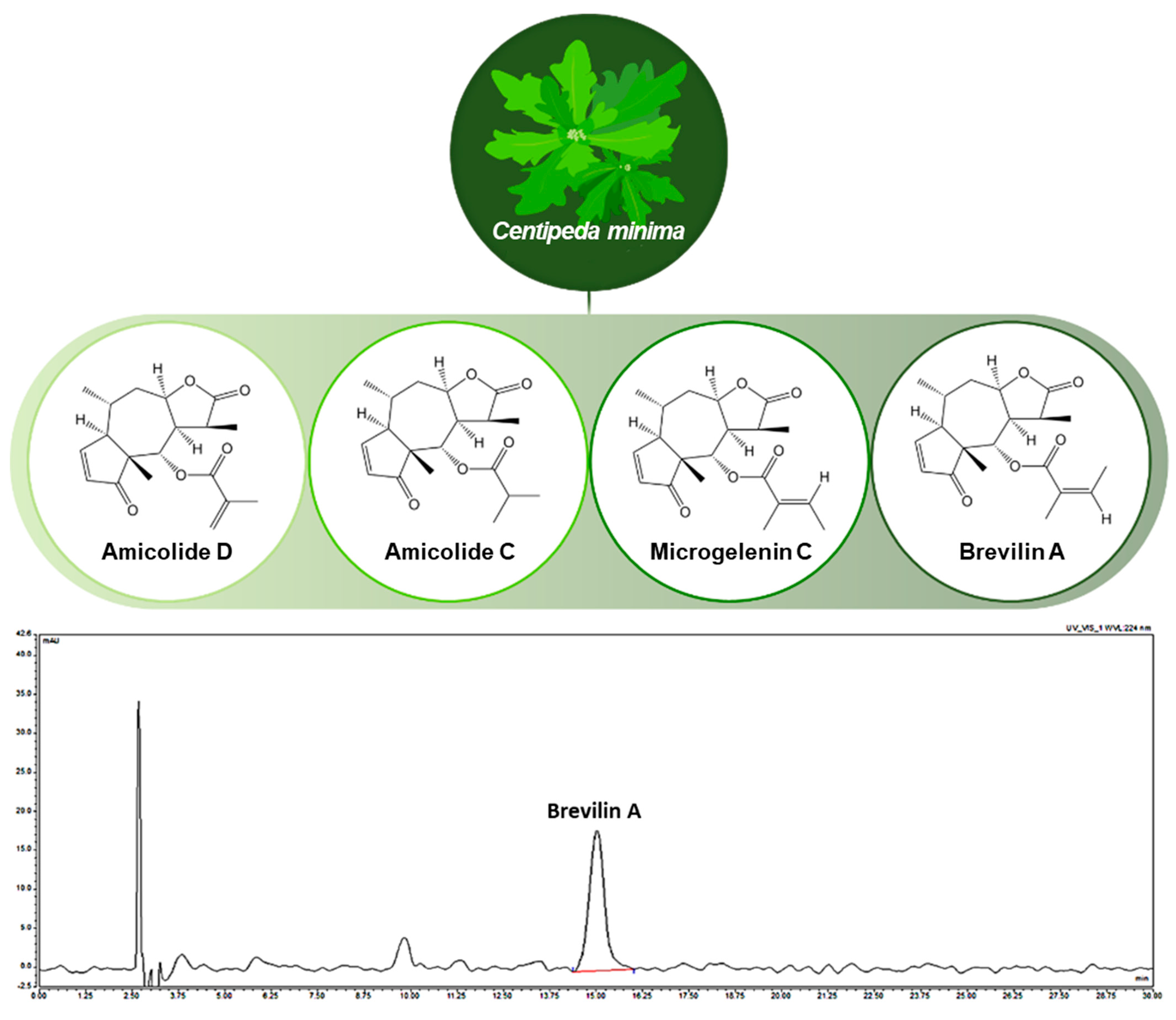
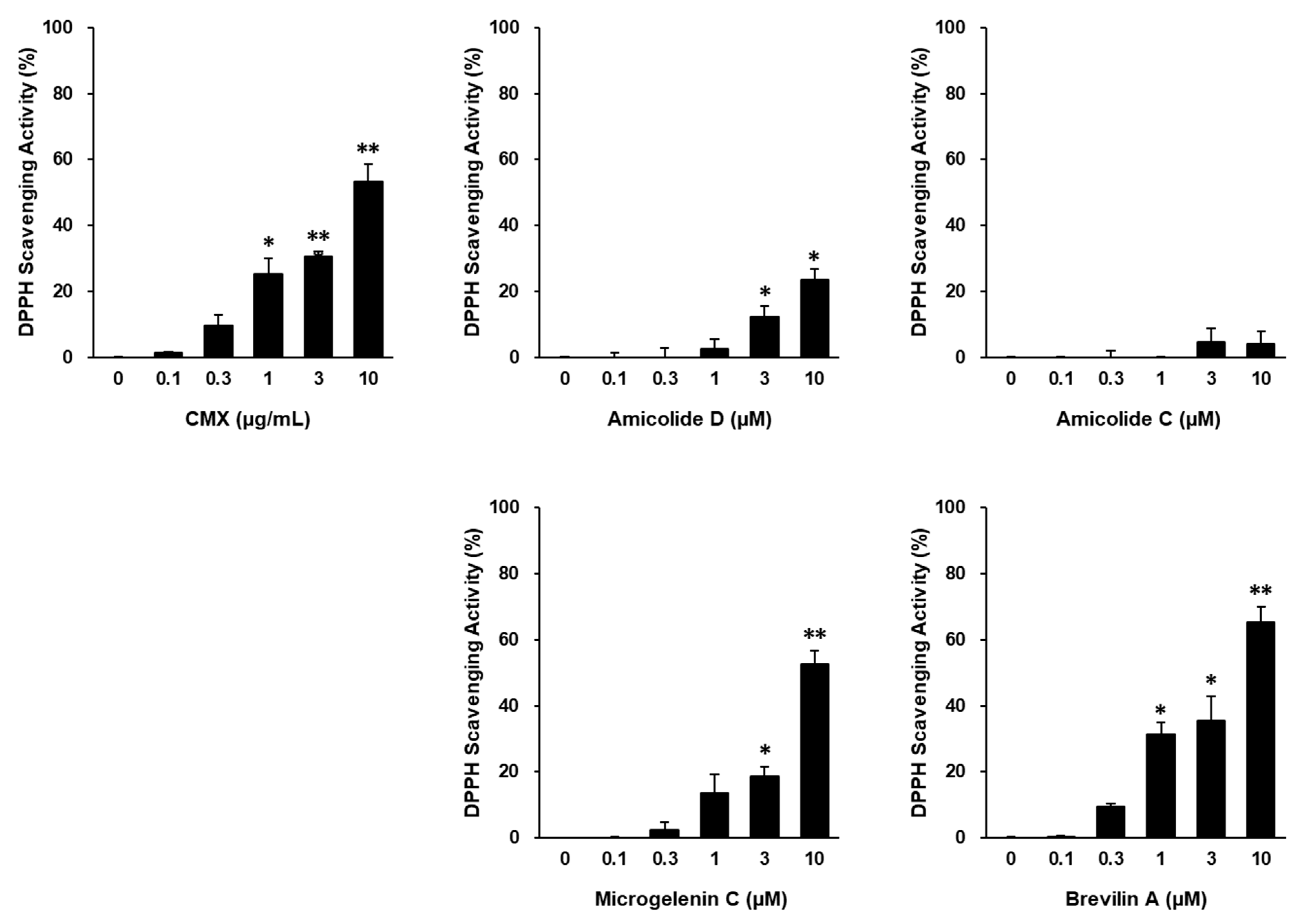
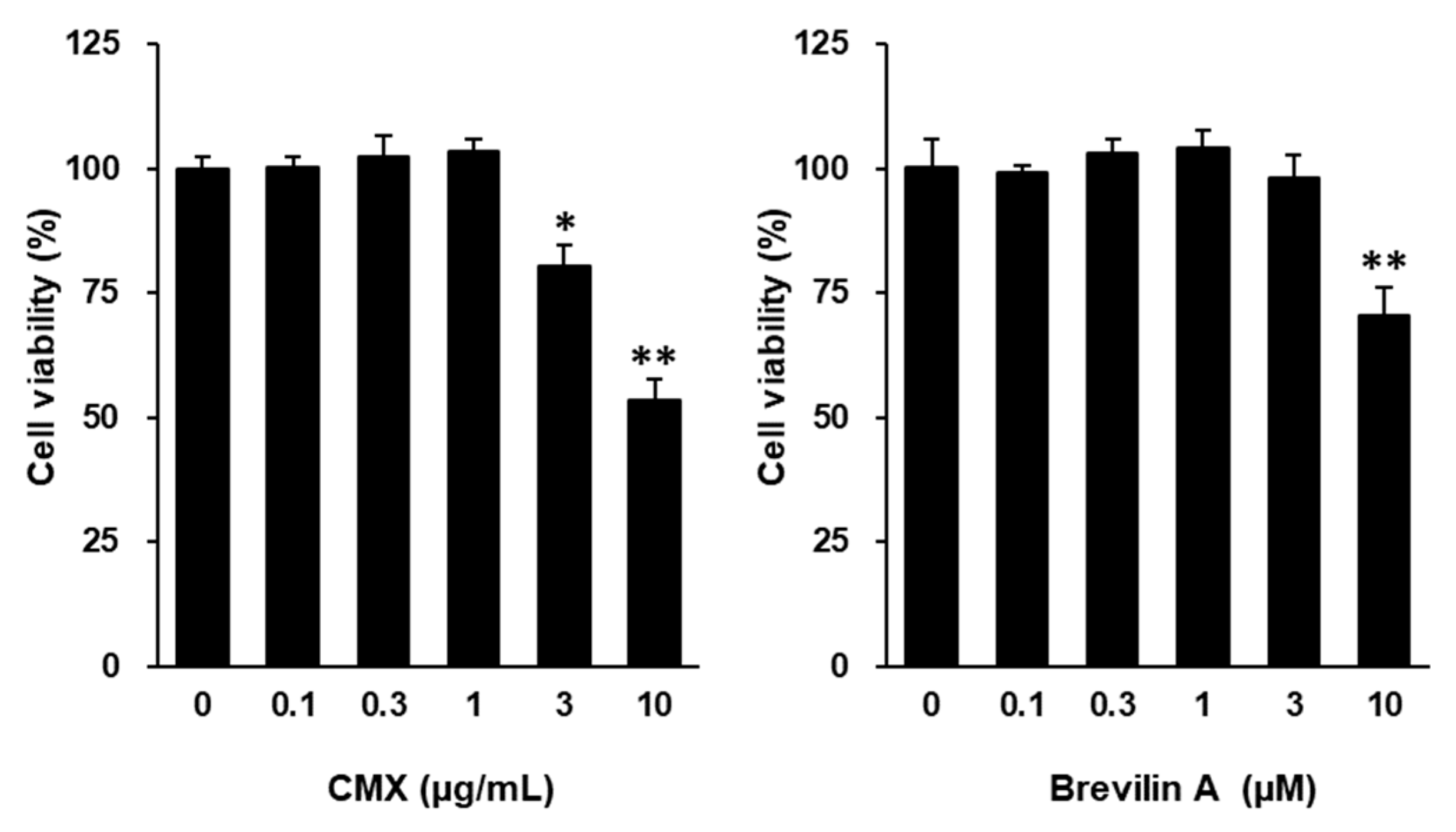
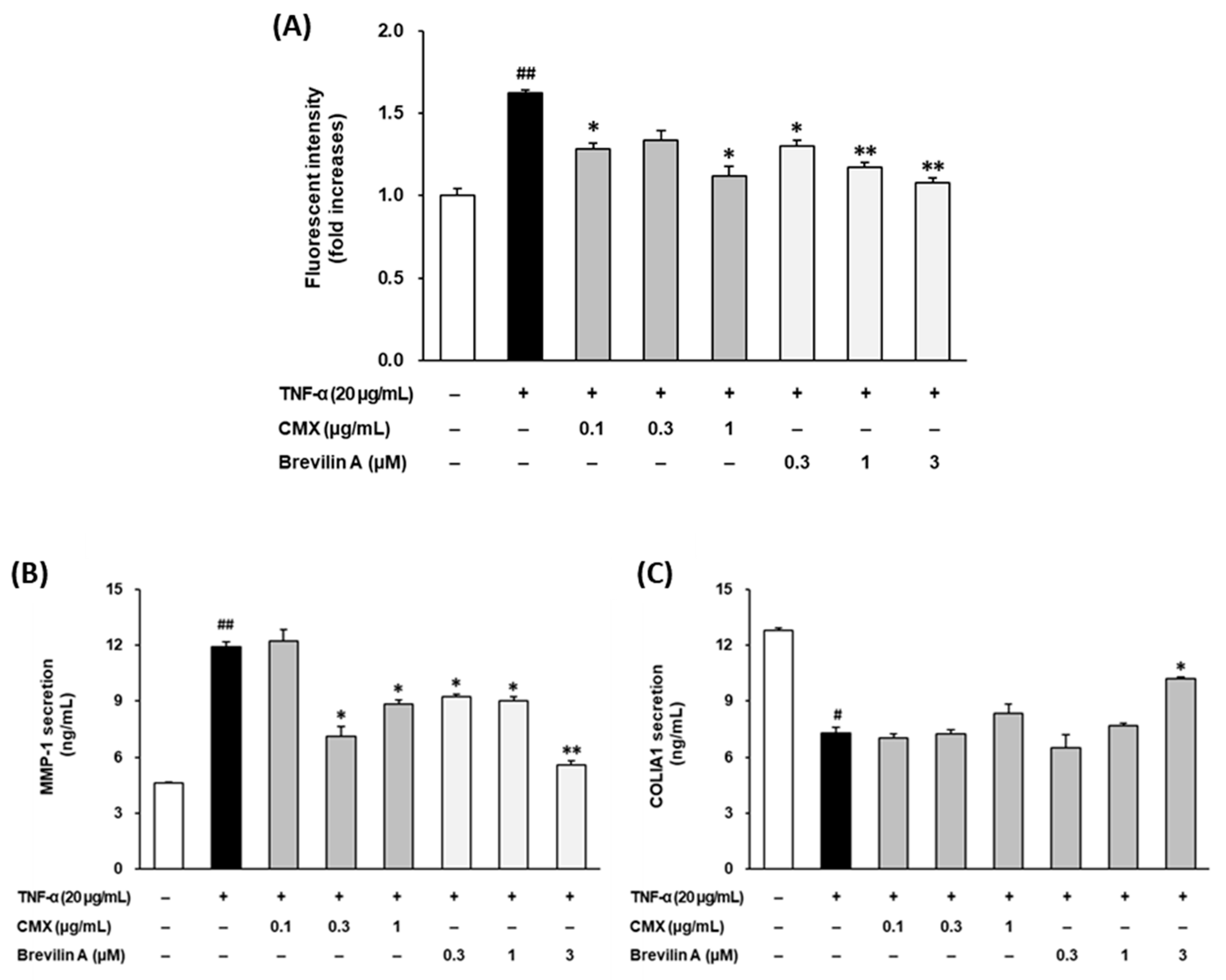
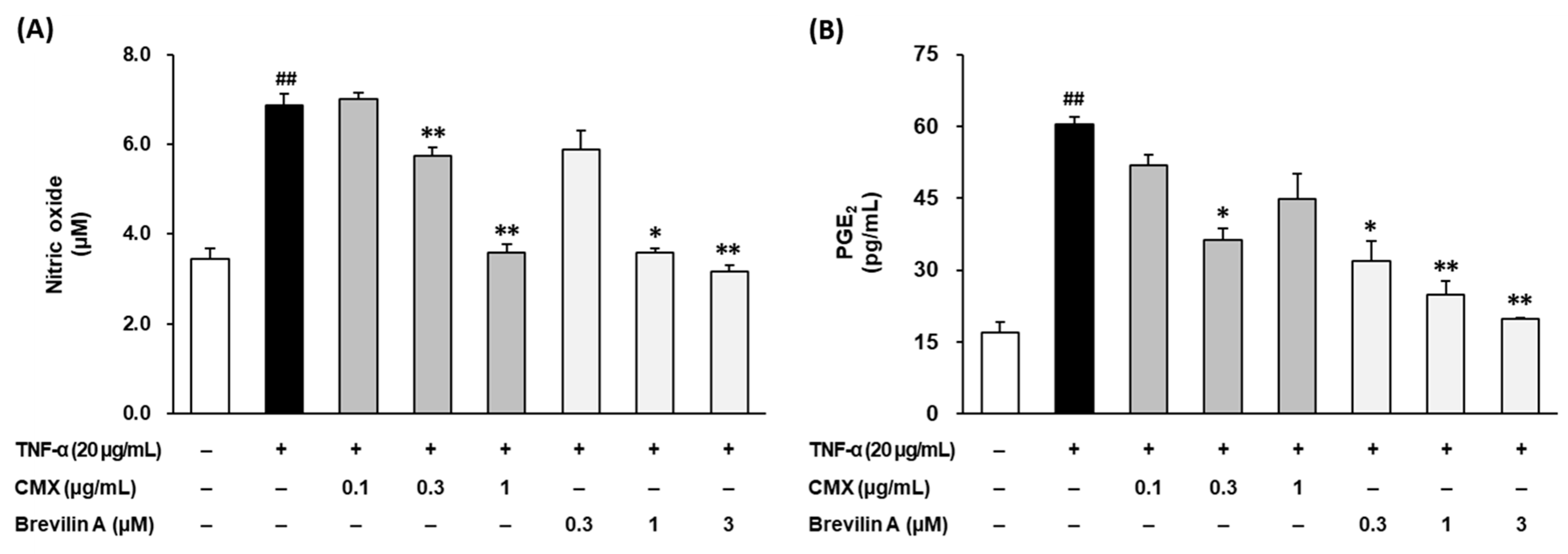
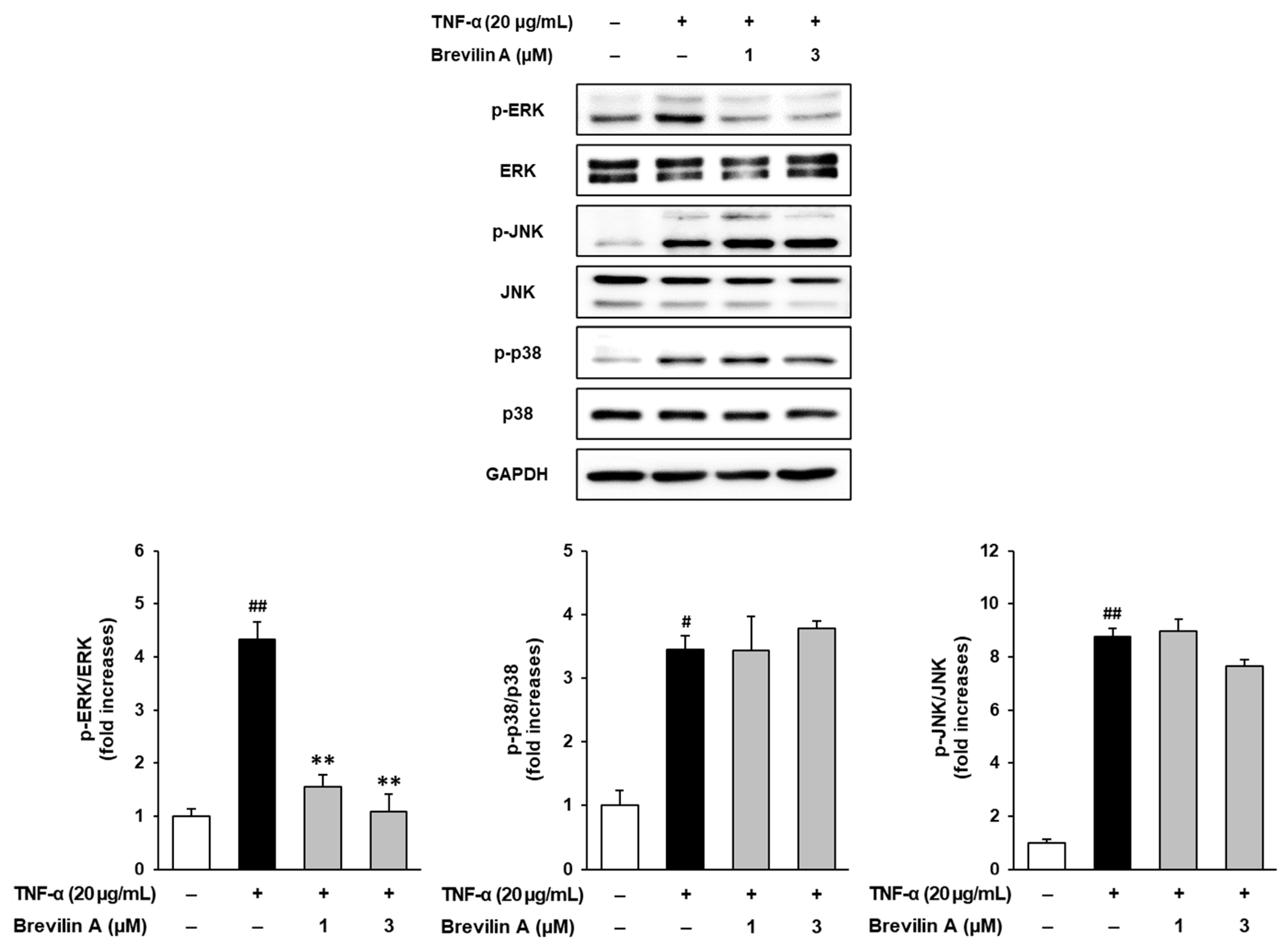
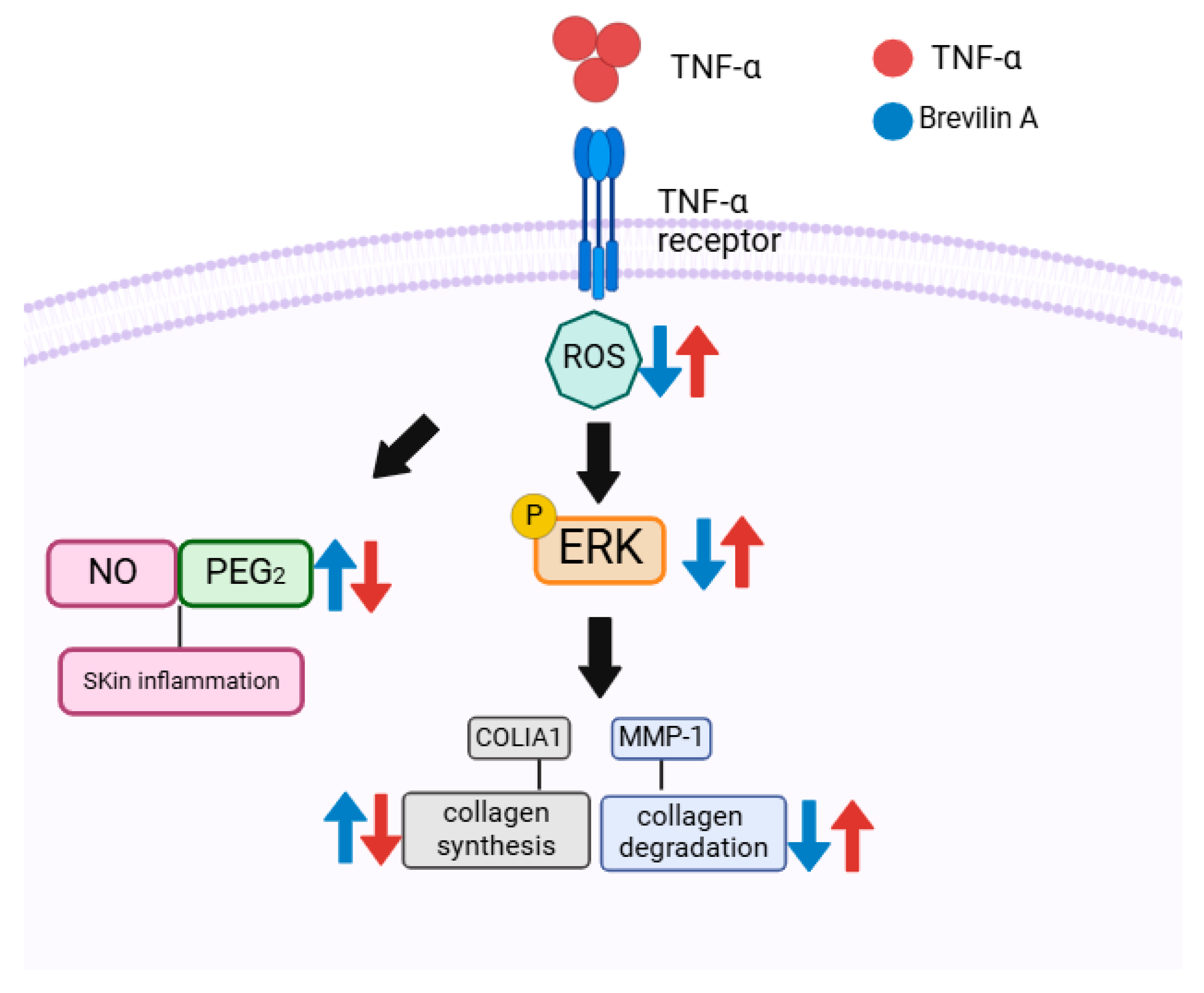
Disclaimer/Publisher’s Note: The statements, opinions and data contained in all publications are solely those of the individual author(s) and contributor(s) and not of MDPI and/or the editor(s). MDPI and/or the editor(s) disclaim responsibility for any injury to people or property resulting from any ideas, methods, instructions or products referred to in the content. |
© 2025 by the authors. Licensee MDPI, Basel, Switzerland. This article is an open access article distributed under the terms and conditions of the Creative Commons Attribution (CC BY) license (https://creativecommons.org/licenses/by/4.0/).
Share and Cite
Lee, S.; Kim, B.H.; Choi, Y.J.; Kim, D.-W.; Cho, E.; Kang, M.; Kim, D.; Pyo, J.; Kang, K.S. Inhibition of TNF-α-Induced Collagen Degradation and Oxidative Damage by Centipeda minima and Brevilin A in Human Dermal Fibroblasts. Curr. Issues Mol. Biol. 2025, 47, 376. https://doi.org/10.3390/cimb47050376
Lee S, Kim BH, Choi YJ, Kim D-W, Cho E, Kang M, Kim D, Pyo J, Kang KS. Inhibition of TNF-α-Induced Collagen Degradation and Oxidative Damage by Centipeda minima and Brevilin A in Human Dermal Fibroblasts. Current Issues in Molecular Biology. 2025; 47(5):376. https://doi.org/10.3390/cimb47050376
Chicago/Turabian StyleLee, Sullim, Byoung Ha Kim, Yea Jung Choi, Dong-Wook Kim, Eunsu Cho, Moonseok Kang, Doeun Kim, Jaesung Pyo, and Ki Sung Kang. 2025. "Inhibition of TNF-α-Induced Collagen Degradation and Oxidative Damage by Centipeda minima and Brevilin A in Human Dermal Fibroblasts" Current Issues in Molecular Biology 47, no. 5: 376. https://doi.org/10.3390/cimb47050376
APA StyleLee, S., Kim, B. H., Choi, Y. J., Kim, D.-W., Cho, E., Kang, M., Kim, D., Pyo, J., & Kang, K. S. (2025). Inhibition of TNF-α-Induced Collagen Degradation and Oxidative Damage by Centipeda minima and Brevilin A in Human Dermal Fibroblasts. Current Issues in Molecular Biology, 47(5), 376. https://doi.org/10.3390/cimb47050376







